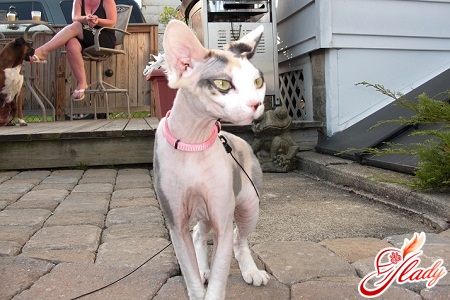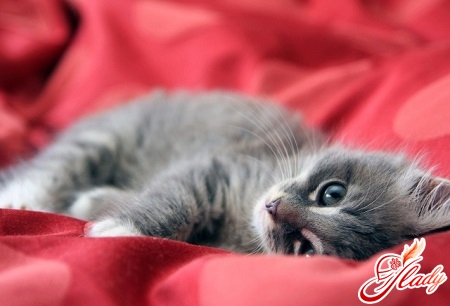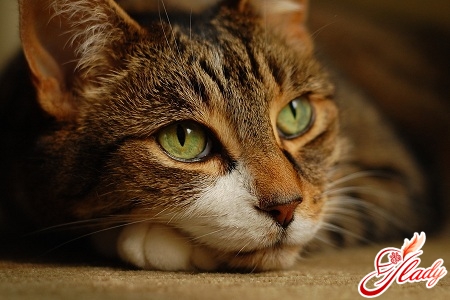 In general, cats rarely get sick.But they also have their own "Achilles heel". The most famous disease of cats is ringworm. And in this case, the saying "it will heal like on a cat" does not work. This disease will not go away on its own, and the animal will not recover without your help. Therefore, it is imperative to treat ringworm. Otherwise, everything will turn out catastrophically, since ringworm is contagious and is transmitted not only to cats, but also to other pets and even to humans. Let's find out what kind of disease it is and how to treat it.
In general, cats rarely get sick.But they also have their own "Achilles heel". The most famous disease of cats is ringworm. And in this case, the saying "it will heal like on a cat" does not work. This disease will not go away on its own, and the animal will not recover without your help. Therefore, it is imperative to treat ringworm. Otherwise, everything will turn out catastrophically, since ringworm is contagious and is transmitted not only to cats, but also to other pets and even to humans. Let's find out what kind of disease it is and how to treat it.
What is ringworm?
Lichen is an infectious disease of the skin andhair. It is caused by various types of microscopic fungi called dermatomycetes. Two types of fungal diseases are called ringworm: trichophytosis and microsporia. They are united under a common name due to the similarity of external signs. But this group also includes another fungal disease - favus. Cat owners know favus as "mange" (hence, by the way, the expression "to become mangy"). Fortunately, this disease is rare in domestic cats. Ringworm does not appear immediately after infection: the incubation period sometimes lasts up to three months. The first noticeable signs of the disease are round spots without hair (bald spots). At first, these spots are small, but gradually (without timely treatment) they "grow", becoming larger and larger and occupying an increasing surface area of the cat's body. Initially, spots appear on the animal's muzzle, ears, tail and paws. With ringworm, the affected skin is covered with gray, greasy scales. The disease can occur in different forms. The mildest form of the disease is superficial, more serious and dangerous is the deep form of ringworm. Kittens, older cats and animals with weakened immunity are most often susceptible to this form. The third form of ringworm is atypical. With this form of the disease, separate hairless areas appear on the cat's body. By the way, sparse hairs often continue to grow in the affected areas. Sometimes ringworm in this form can easily be confused with abrasions or scratches. This makes it difficult to recognize the disease. The superficial form of ringworm is also difficult to diagnose, because upon external examination (especially in long-haired cats), the spots are not always noticeable.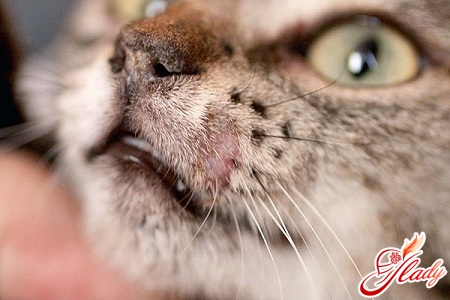
How animals become infected with ringworm
It is no coincidence that ringworm is the most well-knowncat disease: it is very easy to catch this disease. The infection itself occurs through direct contact with a sick animal or through objects that an infected cat has touched. The causative agents of this disease are quite resistant in the external environment and can remain viable even for several years. Poor conditions of keeping, chronic diseases of the animal and its weakened immunity or the "tender age" of kittens increase the risk of infection, as well as minor injuries. In addition, this disease can also be carried by rodents. Therefore, most often, homeless animals suffer from ringworm. And they become the main source of infection. But even if your cat never leaves the house, she can also get ringworm. In this case, most often people bring the infection into the house on their own shoes. And if the cat freely walks on the street, then sooner or later it will catch this infection. Therefore, it is necessary to take preventive measures and regularly vaccinate the cat against fungal infections. Naturally, the category of preventive measures includes compliance with the rules for keeping animals and visiting a veterinarian.
Diagnosis of ringworm
If upon visual inspection you notice on the bodyIf your cat has bald spots or areas with broken hair, contact your doctor immediately. However, in mild forms of the disease, it can be very difficult to recognize ringworm. Therefore, regular preventive examinations by a veterinarian will help to identify ringworm, even if there are no external signs of this disease. In a veterinary clinic, ringworm is diagnosed using a special ultraviolet lamp (Wood's lamp). When illuminated by this lamp, the affected areas will show their emerald-green glow. However, even such diagnostics do not give a 100% result. Therefore, at the first suspicion of the disease, it is necessary to conduct laboratory tests. With this method of diagnosis, scrapings from the animal's fur and skin will be taken and treatment will be prescribed.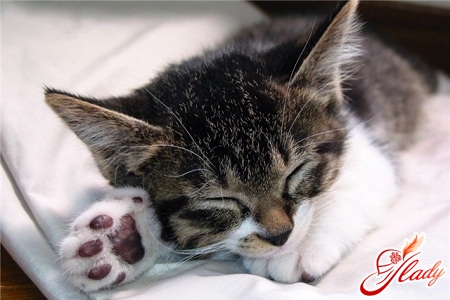
How and what to treat the deprivation of cats
Today, ringworm is no longer consideredan incurable disease. In the past, animals with microsporia were euthanized (by law!). Today, to the great happiness of pet owners, effective drugs have appeared. To treat ringworm, antibiotics are prescribed and special vaccines are used, the affected areas are treated with antifungal drugs and antiseptics. Of course, a veterinarian will prescribe a full course of treatment, but this disease can and should be treated at home. All hair near the ringworm must be cut off. The crusts that appear and dry must be softened with a warm soapy solution, and the spots themselves must be lubricated with iodine or brilliant green. Sulfur ointment and "human" antifungal ointments are also considered a good remedy for ringworm. Everything that is removed from the skin during treatment must be burned, and the room must be regularly disinfected. Try to isolate the sick cat. In any case, do not let it on the sofa and (especially!) in the bed. When handling an animal, wear gloves and wipe your hands with disinfectant solutions. And even better, try to prevent such a nuisance as ringworm. Be sure to vaccinate your pet. Fortunately, today there are vaccines that protect animals from ringworm infection. This vaccination is done twice, with a two-week break, and the animal's immunity is formed after a month. And remember that these vaccinations need to be done annually, since the protection "works" only twelve months. By the way, if a previously vaccinated animal suddenly gets ringworm, it will cope with the disease easier. But most importantly, remember the need to show your cat to the veterinarian. Only a specialist can make the correct diagnosis and prescribe effective treatment. And your task is to provide first aid, follow the doctor's recommendations and observe preventive measures. Do not be arrogant and stubborn. Of course, advice can also be useful, but while you are looking for an answer to the question of how to treat ringworm in cats, the animal suffers, and the disease progresses. We advise you to read:




